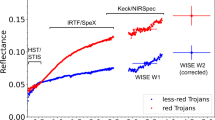Abstract
Physical studies have shown that most asteroids are covered with material of low visual albedo (pv∼0.04) having flat, nearly featureless reflection spectra between 0.4 and 1.1 µm (ref. 1). This large class of objects, the C asteroids, accounts for a progressively larger fraction of minor planets as one goes from the inner to the outer regions of the asteroid belt, a trend which has been interpreted as evidence of a decrease in effective condensation temperature in the original solar nebula with increasing distance from the proto-Sun2. We suggest here that the very low albedos and red spectra of some Trojan asteroids can be explained by the presence of kerogen-like organic compounds. Materials containing these types of carbonaceous substances, rather than those found in the more familiar carbonaceous chondrite matrix, may have been the primary rocky condensate in the outer Solar System and may therefore be typical of the rocky component of comet nuclei.
Similar content being viewed by others
References
Bowell, E., Chapman, C. R., Gradie, J. C., Morrison, D. & Zellner, B. Icarus 35, 313–335 (1978).
Zellner, B. in Asteroids (ed. Gehreis, T.) 783–808 (University of Arizona Press, Tucson, 1979).
Gaffey, M. J. & McCord, T. B. Space Sci. Rev. 21, 555–628 (1978).
Johnson, T. V. & Fanale, F. P. J. geophys. Res. 78, 8507–8518 (1973).
French, L. thesis, Cornell Univ. (1979).
Degewij, J. & Van Houten, C. J. in Asteroids (ed. Gehreis, T.) 417–435 (University of Arizona Press, Tucson, 1979).
Chapman, C. R. & Gaffey, M. J. in Asteroids (ed. Gehreis, T.) 655–687 (University of Arizona Press, Tucson, 1979).
McCall, G. J. Meteorites and Their Origins (Wiley, New York, 1973).
Nagy, B. Carbonaceous Meteorites (Elsevier, New York, 1975).
Gelpi, E., Han, J., Nooner, D. W. & Oro, J. Geochim. cosmochim. Acta 34, 965–979 (1970).
Bandurski, E. L. & Nagy, B. Geochim. cosmochim. Acta 40, 1397–1406 (1976).
Anders, E., Hayatsu, R. & Studier, M. H. Science 182, 781–790 (1973).
Sill, G. Commun. Lunar planet. Lab. 10, 1–7 (1973).
Hunt, G. R. & Salisbury, J. W. Mod. Geol. 1, 283–300 (1970).
Author information
Authors and Affiliations
Rights and permissions
About this article
Cite this article
Gradie, J., Veverka, J. The composition of the Trojan asteroids. Nature 283, 840–842 (1980). https://doi.org/10.1038/283840a0
Received:
Accepted:
Issue Date:
DOI: https://doi.org/10.1038/283840a0
- Springer Nature Limited
This article is cited by
-
Surface Compositions of Trojan Asteroids
Space Science Reviews (2024)
-
Complex organics in space from Solar System to distant galaxies
The Astronomy and Astrophysics Review (2016)
-
Organic matter in space: from star dust to the Solar System
Astrophysics and Space Science (2009)
-
Asteroids: Distributions, morphologies, origins and evolution
Surveys in Geophysics (1992)
-
Spectral-compositional variations in the constituent minerals of mafic and ultramafic assemblages and remote sensing implications
Earth, Moon and Planets (1991)





